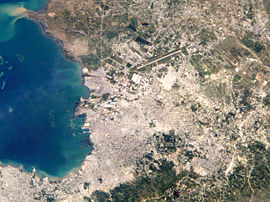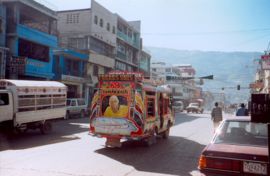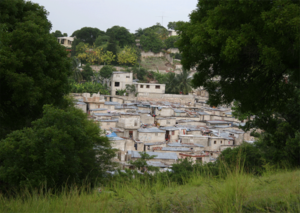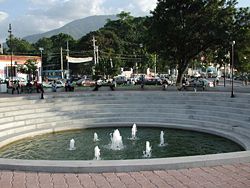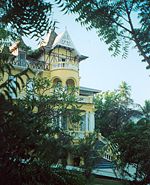Port-au-Prince
2008/9 Schools Wikipedia Selection. Related subjects: Central and South America; Cities
| Ville de Port-au-Prince (Vil Pòtoprens in Haitian Creole) |
|
| Map of Haiti with Port-au-Prince shown | |
| Coordinates: | |
|---|---|
| Country | Haiti |
| Department | Ouest |
| Arrondissement | Port-au-Prince |
| Founded | 1749 |
| Colonial seat | 1770 |
| Government | |
| - Mayor | Jean Yves Jason |
| Population (2007) | |
| - City | 1,082,800 |
| - Metro | 1,728,100 |
| Sister cities |
|---|
Port-au-Prince (pronounced /ˌpɔɹtəʊˈpɹɪns/ in English and /pɔʁopʁɛ̃s/ in French; Haitian Creole: Pòtoprens) is the capital and largest city of Haiti. Growth, especially in crowded slums in nearby plains and hillsides, has raised the population of the Port-au-Prince area to between 2.5 and 3 million. It is located on a bay of the Gulf of Gonâve, at . The city's layout is somewhat similar to that of an amphitheatre; commercial districts are near the water, while residential neighborhoods are located on the hills above.
History
The region before the founding of Port-au-Prince
Before the arrival of Christopher Columbus, the region that would eventually become Port-au-Prince was not the site of any permanent human settlement. At the end of the 15th century, the region was under the control of an Amerindian ruler by the name of Bohechio, and he, like his predecessors, feared settling too close to the coast -- such settlements would have proven to be tempting targets for the Caribes, who lived on neighbouring islands. Instead, the region served as a hunting ground.
With the arrival of the Spaniards, the Amerindians were forced to become a protectorate, and Bohechio, childless at death, was succeeded by his sister, Anacaona, wife of the cacique Caonabo. Anacaona tried to maintain cordial relations with the Spaniards, but this proved to be difficult, as the latter came to insist upon larger and larger tributes. Eventually, the Spanish colonial administration decided to rule directly, and in 1503, Nicolas Ovando, then governor, set about to put an end to the régime headed by Anacaona. He invited her and other tribal leaders to a feast, and when the Amerindians had drunk a good deal of wine -- the Spaniards did not drink on that occasion -- he ordered most of the guests killed. Anacaona was spared, though only to be hanged publicly some time later. Through violence and disease, the Spanish settlers decimated the native population.
Direct Spanish rule over the area having been established, Ovando founded a settlement not far from the coast (west of Etang Saumâtre), ironically named Santa Maria de la Paz Verdadera, which would be abandoned several years later. Not long thereafter, Ovando founded Santa Maria del Puerto. The latter was first burned by French explorers in 1535, then again in 1592 by the English. These assaults proved to be too much for the Spanish colonial administration, and in 1606, it decided to abandon the region.
For more than 50 years, the area that is today Port-au-Prince saw its population drop off drastically. Finally, some buccaneers began to use it as a base, and Dutch merchants began to frequent it in search of leather, as game was abundant there. Around 1650, French pirates, or flibustiers, running out of room on the Île de la Tortue began to arrive on the coast, and established a colony at Trou-Borded. As the colony grew, they set up a hospital not far from the coast, on the Turgeau heights. This led to the region being known as Hôpital.
Although there had been no real Spanish presence in Hôpital for well over 50 years, Spain retained its formal claim to the territory, and the growing presence of the French flibustiers on ostensibly Spanish lands provoked the Spanish crown to dispatch Castilian soldiers to Hôpital to retake it. The mission proved to be a disaster for the Spanish, as they were outnumbered and outgunned, and in 1697, the Spanish government signed the Treaty of Ryswick, renouncing any claims to Hôpital. Around this time, the French also established bases at Ester (part of Petite-Rivière) and Gonaïves.
Ester was a rich village, inhabited by merchants, and equipped with straight streets; it was here that the governor lived. On the other hand, the surrounding region, Petite-Rivière, was quite poor. Following a great fire in 1711, Ester was abandoned. Yet the French presence in the region continued to grow, and not long thereafter, a new city was founded to the south: Léogane.
While the first French presence in Hôpital, the region that was later to contain Port-au-Prince, was that of the flibustiers, as the region became a real French colony, the colonial administration began to worry about the continual presence of these pirates. While useful in repelling Englishmen intent on encroaching upon French territory, they were relatively independent, unresponsive to orders from the colonial administration, and a potential threat to it. Therefore, in the winter of 1707, Choiseul-Beaupré, the governor of the region, sought to get rid of what he saw as a threat. He insisted upon control of the hospital, but the flibustiers refused, considering this humiliating. They proceeded to close the hospital, rather than cede control of it to the governor, and many of them became habitans (farmers) -- the first long-term European inhabitants in the region.
Though the elimination of the flibustiers as a group from Hôpital reinforced the authority of the colonial administration, it also made the region a more attractive target for the English. In order to protect the area, in 1706 a captain named de Saint-André sailed into the bay just below the hospital, in a ship named Le Prince. It is said that M. de Saint-André named the area Port-au-Prince (meaning "Port of the Le Prince"), although the port and the surrounding region continued to be known as Hôpital (however, the islets in the bay had already been known as les îlets du Prince as early as 1680.)
The English did not trouble the area, and various nobles sought land grants from the French crown in Hôpital; the first noble to control Hôpital was Sieur Joseph Randot. Upon his death in 1737, Sieur Pierre Morel gained control over part of the region, with Gatien Bretton des Chapelles acquiring another portion of it.
By this time, the colonial administration was convinced that a capital needed to be chosen, in order better to control the French portion of Santo-Domingo ( Hispaniola). For a time, Petit-Goâve and Léogane vied for this honour, but both were eventually ruled out, for various reasons. First of all, neither was centrally located. Petit-Goâve's climate was too malarial, and Léogane's topography made it difficult to defend. Thus, in 1749 a new city was built: Port-au-Prince.
Colonial history
In 1770, Port-au-Prince replaced Cap-Français (the modern Cap-Haïtien) as capital of the colony of Saint-Domingue, and in 1804, it became the capital of newly-independent Haïti. Before Haïtian independence, it was captured by British troops on June 4, 1794. During the French and Haïtian Revolutions, it was known as Port-Républicain, before being renamed Port-au-Prince by Jacques I, emperor of Haïti. When Haïti was divided between a kingdom in the north and a republic in the south, Port-au-Prince was the capital of the republic, under the leadership of Alexandre Pétion. Henri Christophe renamed the city Port-aux-Crimes after the assassination of Jacques I at Pont Larnage (now known as Pont-Rouge, and located north of the city.)
Economy
Port-au-Prince is the nation's largest centre of economy and finance. The city currently exports its most widely consumed produce of coffee and sugar, and has, in the past, exported other goods, such as shoes and baseballs. Port-au-Prince has food-processing plants as well as soap, textile, and cement factories. Despite political unrest, the city also relies on the tourism industry and construction companies to move its economy. Port-au-Prince was once a popular place for cruises, but has since lost nearly all of its tourism, and no longer has cruise ships coming into port.
Though unemployment is very high in Port-au-Prince, it would be more accurate to say that people are underemployed. Walking down the streets of Port-au-Prince a person cannot help but recognize the extremely high levels of activity, especially among people selling goods and services right off the streets. In Simon M. Fass's research book, Political Economy in Haïti: The Drama of Survival, he argues that in fact virtually no one is unemployed in Port-au-Prince's slums, because they would be unable to survive if they were. Port-au-Prince has several rather upscale districts in which crime rates are much lower than the centre of the capital.
Demographics
The population of the Port-au-Prince metro area is greater than 2 million. The majority of the population is of black African descent, but a prominent mulatto minority controls many of the city's businesses. There are sizeable numbers of Hispanic residents and business-owners as well as small numbers of whites (mostly foreign-born, temporary residents). Citizens of Middle Eastern (particularly Syrian and Lebanese) ancestry are a growing minority with a significant presence in the capital. Arab Haitians (in which a large number live in the capital) are more often than not, concentrated in financial areas where the majority of them establish businesses. The majority of the city's poorer inhabitants are concentrated in densely populated slums such as La Saline, located directly north of downtown and west of the middle-class Delmas neighbourhood, Bel-Air, Martissant, and the poorest, most-dangerous slum, Cité Soleil, located directly north of La Saline. In fact, the downtown area is nearly completely engulfed in its own slums. There are however, many comfortable living quarters in the city, especially in the southeastern portion of the city around the School of Sacred Heart (École du Sacré-Cœur), and going towards the wealthy upper class suburb of Pétionville. Pétionville is known for its plush mansions on the hills overlooking Port-au-Prince from the southeast, but it too, has begun to receive an inundation of migrants from the countryside where farmland is eroding into desert and many people come to the city to search for jobs. The government cannot accommodate the flood of migrants into the city. Hence, there are shantytowns erecting even in Pétionville, as well as in nearby districts like Carrefour, and the financially wealthier (when compared to the former) district of Delmas. Most of the mulattos in the city are concentrated and reside within these wealthier areas of Port-au-Prince.
City layout
Port-au-Prince over the years has become rather disorderly in its urban planning. Modernization is gradually countering this however. Port-au-Prince is subdivided into various districts and neighborhoods. There are a ring of districts that radiate out from the centre of Port-au-Prince. Pétionville is an affluent suburb under Port-au-Prince's jurisdiction located southeast of the city. Delmas is located directly south of the airport and north of the central city, and Carrefour which is quite poor, especially when compared with the other two suburbs is located southwest of central Port-au-Prince. Downtown Port-au-Prince harbors many low-income slums plagued with poverty and violence in which the most notorious, Cité Soleil is situated. The Champ de Mars area has begun some modern infrastructure development as of recently. The Downtown area is the site of several projected modernization efforts in the capital.
Government
The current mayor of Port-au-Prince is Jean-Yves Jason. The city's separate districts (primarily the districts of Delmas, Carrefour, and Pétionville) are all administered by their own local mayors who in turn fall under the jurisdiction of the city's general mayor. The seat of the state, the Presidential Palace, is located in the Champ de Mars plaza of the city. The PNdH (Police Nationale d’Haïti) is the authority governing the enforcement of city laws. The national police force as of recently, have been increasing in number. However because of its ailing ineffectiveness and insufficient manpower, a significant number of UN personnel is present throughout the city as part of the stabilization mission in Haiti.
Transportation
All of the major transportation systems in Haiti are located near or run through the capital. Haiti has two main highways that run from one end of the country to the other. The northern highway, Route Nationale #1 (National Highway One), originates in Port-au-Prince, winding through the coastal towns of Montrouis and Gonaïves, before reaching its terminus at the northern port Cap-Haïtien. The southern highway, Route Nationale #2, links Port-au-Prince with Les Cayes via Léogâne and Petit Goâve. Maintenance for these roads lapsed after the 1991 coup, prompting the World Bank to loan USD 50 million designated for road repairs. The project was canceled in January 1999, however, after auditors revealed corruption. Haiti also has a third major highway, the Route Nationale #3, which connects Port-au-Prince to Cap-Haitien via the towns of Mirebalais and Hinche. This route links the capital and Le Cap to the central plateau; however, due to its poor condition, it sees limited use.
The most common form of public transportation in Haiti is the use of brightly painted pickup trucks as taxis called "tap-taps" They are named this because when a passenger needs to be let off they use their coin money to tap the side of the vehicle and the driver usually stops. Most tap-taps are fairly priced at around 1-3 goudes per ride within a city. The catch to the price is that the driver will often fill a truck to maximum capacity, which is nearly 20-30 people.
The port at Port-au-Prince has more registered shipping than any of the over dozen ports in the country. The port's facilities include cranes, large berths, and warehouses, but these facilities are in universally poor shape. The port is underused, possibly due to the substantially high port fees compared to ports in the Dominican Republic.
The Toussaint Louverture International Airport (Aéroport International Toussaint Louverture), which opened in 1965 (as the François Duvalier International Airport), is located 10 km north of the city. It is Haiti's only jetway, and as such, handles the vast majority of the country's international flights. Air Haïti and a handful of major airlines from Europe, the Caribbean, and the Americas serve the airport. Since 2007, the airport has been set to undergo an expansion in which a new set of terminals will be built.
Education
Port-au-Prince contains various educational institutions ranging from small vocational schools to universities. Influential international schools in Port-au-Prince include Union School , founded in 1919, and Quisqueya Christian School , founded in 1974. Both schools offer an American-style pre-college education. French-speaking students can attend the Lycée Français, located in Bourdon. The State University of Haiti (Université d'État d'Haïti in French or UEH), is located within the capital along other universities such as the Quisqueya University and the Université des Caraïbes. There are many other institutions that observe the Haitian scholastic program. Many of them are religious academies led by foreign missionaries from France or Canada. To name a few of these establishments: Institution Saint-Louis-de-Gonzague, École Sainte-Rose-de-Lima, École Saint-Jean-Marie Vianney, Institution du Sacré-Coeur, Collège Anne-Marie Javouhey and many more.
The Ministry of Education is also located in downtown Port-au-Prince at the Palace of Ministries, adjacent to the National Palace in the Champ de Mars plaza.
The Haïtian Group of Research and Pedagogical Activities (GHRAP) has set up several community centers for basic education. UNESCO’s office at Port-au-Prince has taken a number of initiates in upgrading the educational facilities in Port-au-Prince.
Culture
The culture of the city lies primarily in the centre around the National Palace as well as its surrounding areas. The national palace was one of the early structures of the city but was destroyed and then rebuilt in 1918. A popular destination in the capital is the Hotel Oloffson, a 19th century gingerbread mansion that was once the private home of two former Haïtian presidents. It has become a popular hub for tourist activity in the central city. The Cathédrale de Port-au-Prince is a famed site of cultural interest and attracts foreign visitors to its Neo-Romantic architectural style. The Musée d'Art Haïtien du Collège Saint-Pierre contains some of the country's most talented art and the Musée National is a museum featuring historical artifacts such as King Henri Christophe's actual suicide pistol and a rusty anchor that museum operators claim was salvaged from Christopher Colombus' ship, the Santa Maria. Other notable cultural sites include the Archives Nationales, and the Bibliothèque nationale (National library).
Tourism
Port-au-Prince has managed to maintain a tourism industry despite political instability. The Toussaint Louverture International Airport (referred to often as the Port-au-Prince International Airport) is the country's main international gateway for tourists. The Pétionville area of Port-au-Prince is affluent and is generally the most common place for tourists to visit and stay. The vast majority of tourists concentrate their visits around the various cultural sites that exist within the capital, an example being large number of the famous gingerbread-styled houses.
Notable residents
- Claude Vilgrain, first Haitian born NHL player
- Samuel Dalembert, Philadelphia 76ers player
- Sweet Micky, popular Kompa artist
- Wyclef Jean, popular Hip Hop artist
- Olden Polynice, number eight NBA draft pick by the Chicago Bulls before being traded to the Seattle SuperSonics in 1988

